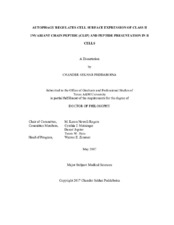| dc.description.abstract | The mechanisms by which the immune system distinguishes self from non-self are essential in providing protection from pathogenic invaders and to prevent autoimmunity. Over the last few decades, the discovery of regulatory cells that can suppress specific immune responses has introduced a paradigm shift in the study of self versus non-self discrimination. Combined with the discovery of pathogen-associated molecular patterns (PAMPS) and damage-associated molecular patters (DAMPS), and their respective Toll Like Receptors (TLRs) that trigger an immediate inflammatory response to dangerous pathogens or to damaged self, recognizing the pathogens specifically, and maintain self-tolerance simultaneously, has led to the requirement for re-assessing both the innate and the adaptive immune response to either. We have examined the contribution of a highly conserved invariant protein, called CD74, to this conundrum.
Our experiments involved both activation with TLR agonists or with antigen-specific receptors to determine the contribution of CD74 in regulating the balance. TLR activation and antigen receptor engagement both result in the proteolysis of CD74 into peptides that get loaded into the peptide-binding groove of MHC-II. We reasoned that CD74 and its products might provide a molecular contribution that would prevent self-antigen presentation until a response to specific exogenous antigens is required. While we observed that both TLR activation and antigen receptor engagement rapidly result in moderate to high levels of cell surface CLIP, respectively, treatment with rapamycin, a well-established inhibitor of mTOR that induces autophagy, resulted in loss of cell surface CLIP under either activation stimulus. Furthermore, by using a synthetic peptide designed to have a high binding constant for the peptide-binding groove of MHC-II, rapamycin rapidly enabled exogenous peptide presentation. The implications of this observation in terms of self versus non-self discrimination are supported by our experiments using autoimmune prone animals. In these studies antigen receptor engagement as well as LPS-induced CLIP expression was reduced by rapamycin treatment, enabling exogenous antigenic peptide presentation. These results suggest that at least for endosomal TLR activation, preferential expression of endogenous self-antigens may contribute to the development of autoimmune responses and reciprocally to self-tolerance that may prevent an anti-tumoral response. | en |


